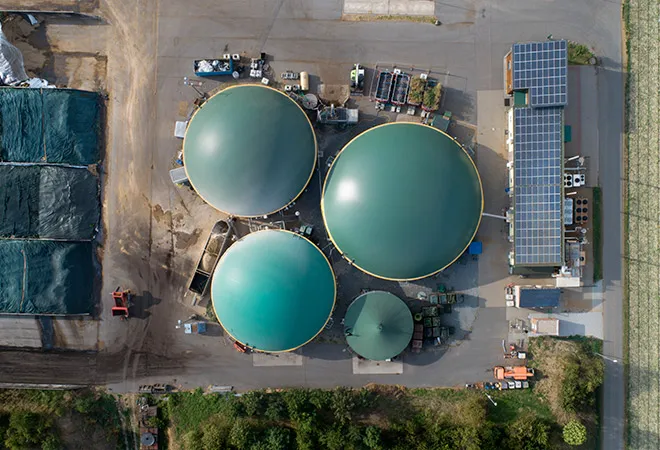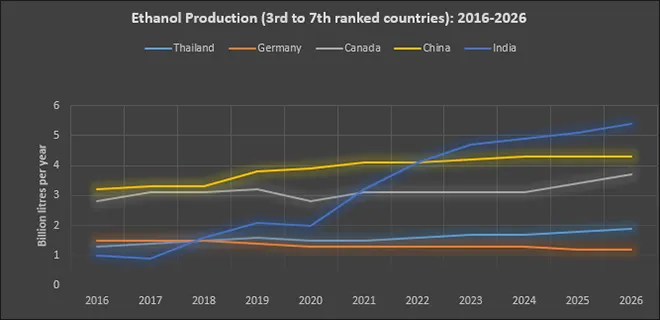
This article is part of the series Comprehensive Energy Monitor: India and the World
According to projections by the IEA (International Energy Agency), India is expected to overtake China to become the
third largest producer of ethanol by 2023. In 2016, India was seventh in the list of top ethanol producers and by 2021 it overtook Germany, Thailand, and Canada to become the fourth largest producer. In 2022, India is likely to match ethanol production from China and by 2023
overtake China to claim the third spot after the USA and Brazil. The spurt in ethanol production in India is almost entirely policy driven. The most recent policy push on which the IEA’s optimistic projections for ethanol production from India are based come from the target set by the
2021 report on ethanol blending by Niti Aayog and the Ministry of Petroleum & Natural gas (MOPNG).
The return to biofuels-based on food-based feedstock has reignited the food versus fuel debate with many environmental organisations criticising the move.
Amongst key recommendations of the report are that the MOPNG mandate
10 percent ethanol blending (E10) in petrol throughout the country by April 2022 and roll out
20 percent ethanol blending (E20) in petrol in a phased manner by April 2023. This brings forward the target set by the national
policy on biofuels 2018 which recommended an indicative target of E20 blending in petrol and 5 percent blending of biodiesel (B5) in diesel by 2030. The 2021
Niti Aayog report is a step backwards from a technology perspective as it has renewed the focus on biofuels that rely on food-based feedstocks, while the 2018 policy emphasised biofuels that rely on non-food biomass. The return to biofuels-based on food-based feedstock has reignited the food versus fuel debate with many environmental organisations criticising the move.
Biofuels
The
two biofuel types that dominate production today are sugar-based bioethanol production and vegetable oil or fatty acid methyl ester (FAME)-based biodiesel. Most of the
first generation biofuels (1GB, primarily bioethanol and biodiesel) are sourced from food-based plants that have energy-containing molecules like sugars, oils and cellulose. Since 2000, the share of biodiesel in total biofuel production has increased nearly ten-fold, from
3.3 percent in 2000 to nearly 32 percent in 2020, but bioethanol still accounts for two thirds of total production. Biofuel yield from 1GBs is limited and it has a negative impact on food security. Second generation biofuels (2GB) use feedstock of
lignocellulosic-(non-starch based fibrous part of plant material) that include straw, bagasse, forest residues (all non-food) and purpose grown energy crops on marginal lands. There are very few commercial scale 2GB production operations today. Third generation (3GB) biofuels are
algae-based and carry the potential to provide a non-food, high-yield, non-arable land use source of biodiesel, bioethanol, hydrogen, etc. 3GBs are in the research and development stage. Research on
fourth generation biofuels (4GB) or photobiological solar fuels and electro fuels that directly convert solar energy into fuel using raw materials that are inexhaustible, cheap and widely available is in its early stages.
Second generation biofuels (2GB) use feedstock of lignocellulosic-(non-starch based fibrous part of plant material) that include straw, bagasse, forest residues (all non-food) and purpose grown energy crops on marginal lands.
The USA is the
largest ethanol producer in the world accounting for 46 percent of global production and the second largest in biodiesel production accounting for 19 percent of production. 87 percent of bioethanol production in the USA is
corn-based. Brazil is the
second largest ethanol producer in the world accounting for 28 percent of global production and 14 percent of biodiesel production. Brazil’s ethanol is derived from sugarcane and its biodiesel from soyabean. The
European Union is the world’s largest biodiesel producer but most of it is produced from imported feedstock. Globally, biofuels accounted for
0.2 percent of total primary energy consumption and
0.7 percent of transportation energy consumption in 2019. In India the share of biofuel consumption in total primary energy consumption was roughly the same at
0.2 percent and its share in transportation was
0.7 percent.
The Rationale for Biofuel use
Biofuels offer both
advantages and disadvantages in terms of environmental, economic and social sustainability. Reduction in greenhouse gas (GHG) emissions, energy security through lower import of crude oil and rural development are the most important drivers for biofuels globally. These are the same benefits that the
report by Niti Aayog offers: Increase energy security as it could potentially reduce import of crude oil, increase participation of local entrepreneurs and
sugarcane farmers in the energy economy and decrease vehicular emissions. While the benefit to farmers is unambiguous because increase in demand for any agricultural crop, not just biofuel crops will benefit farmers, the energy and environment benefits are somewhat ambiguous and highly context specific.
Net Energy Balance
The
overall energy ratio (OER) or the ratio of the energy delivered by the fuel (petroleum or biofuel) to the sum of all energy inputs going into its production is highest for petrol and lowest for cellulosic ethanol. But as the energy input for biofuels is mostly renewable, the
fossil energy ratio (FER) which is the ratio of the liquid energy output to the fossil energy input is lower. For petrol, the FER is the same as that of its
OER at about 0.8 and about
10 for Brazilian sugar cane-based ethanol. The FER is high for sugar cane-based ethanol because most of the energy input to produce ethanol comes from sugarcane fibre. Estimates on the FER for Indian ethanol are not available, but it is likely to be lower than that of Brazilian ethanol because Brazilian ethanol is rated as the most energy efficient amongst biofuels in many studies.
Greenhouse Gas Emissions
The report from
Niti Aayog quotes potential reduction of GHG emission at the point of use, that is from the tailpipe of vehicles, to make its case for ethanol blending. But life
cycle assessment (LCA) studies have considered the carbon mitigation and other environmental impacts of biofuels over its full lifecycle, from plant to fuel. The findings are often conflicting, with a
wide variation in the estimates. One reason for the wide variation is the difficulty in estimating net carbon emissions from land use change involved in biofuel cultivation. All plants and trees are
carbon sinks as they absorb carbon dioxide (CO
2) from the atmosphere through photosynthesis. Burning biofuels in vehicles releases CO
2 back into the atmosphere but as regrowth of new biofuel plants balances the emission of CO
2, biofuels are, in theory,
carbon neutral. But if the land used to grow biofuel crops was a forest which had to be cleared to cultivate biofuel crops, then it removes a huge carbon sink which means the biofuel thus produced is not necessarily carbon neutral. Forest clearing or
land use change (LUC) as it is referred to in academic literature, substantially reduces the environmental benefits of biofuels. For example, the constant increase in demand for sugarcane-based ethanol from Brazil has meant
extensive deforestation of rainforests resulting in GHG emissions from Brazilian ethanol use that was about 60 percent higher than that of petrol.
Burning biofuels in vehicles releases CO2 back into the atmosphere but as regrowth of new biofuel plants balances the emission of CO2, biofuels are, in theory, carbon neutral.
For the Indian context the LCA study on corn-based ethanol production and soyabean-based biodiesel production from China may be more relevant. The study found that GHG emissions from Chinese ethanol and biodiesel was
40 percent and 20 percent higher than petrol and diesel respectively because of the relatively higher use of fertilisers, higher process energy consumption and the coal dominated energy mix. If LUC related GHG emissions are not counted, then GHG emissions from most 1GBs is in the range
3 to 111 grams CO2 eq per MJ (carbon-di-oxide equivalent per million joules) which is lower than that of petroleum-based fuels. However, if LUC is considered, many of the biofuels in use in climate conscious regions such as the EU (European Union) are found to be much higher than that of petrol and diesel.
Issues
Commentary that followed the release of Niti Aayog’s report on biofuels have highlighted the potential food security and water challenges posed by the revised targets for ethanol blending. Sugarcane is a water intensive crop grown on land meant for food production and it is easy to see how the
competing demands from the fuel sector could threaten both water and food security. The response that only surplus sugarcane and rice are diverted to fuel production may not hold in the longer term. Higher than anticipated rainfall from the
monsoons that underpin surplus food grain production cannot sustain an ambitious ethanol blending policy for the future. India is currently a net importer of ethanol as acknowledged in the report by
Niti Aayog which means that it is yet to contribute to increase in energy security. If domestic production does not increase, targets for ethanol blending can be met only by increasing imports. Increase in domestic production will remain a challenge and may come only at the expense of food security as
arable land is scarce for a significant increase in domestic production of biofuels. The gains in tailpipe emissions from ethanol blending are not only too small but also redundant given India’s goal for electrifying surface transport. Benefit to
farmers and rural economies from biofuel production is the key political driver of biofuel production across the world. For resource challenged India, this may bring only few benefits at very high cost.
 Source: International Energy Agency, Renewables 2021
Source: International Energy Agency, Renewables 2021
The views expressed above belong to the author(s). ORF research and analyses now available on Telegram! Click here to access our curated content — blogs, longforms and interviews.





 PREV
PREV




